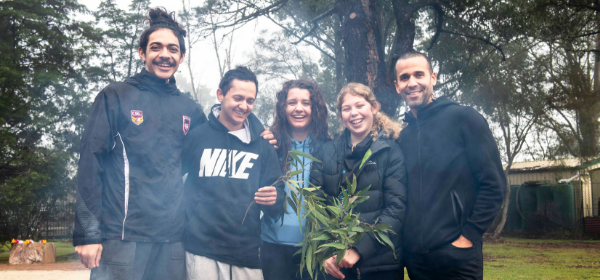NAISDA was honoured to welcome celebrated international performer, choreographer, educator and scholar, Alvin Rangel, back to campus for a second consecutive year to conduct a three-week intensive in the Horton Technique.
The Horton Technique was pioneered by Lester Horton, who developed the dance form throughout the 1920s, 30s and 40s, based on Native American dances, anatomical studies and other movement influences to strengthen and open up the body for performance in any style. The Horton Technique has become an important part of the NAISDA curriculum, helping professional development and enhancing the technical skills of our Developing Artists.
Alvin is an Associate Professor of Dance at California State University-Fullerton, teaching dance composition, improvisation, modern dance, ballet, Horton technique, African American concert dance and dance history. He began his professional career performing ballet and jazz in Puerto Rico and has since had the honour of performing in some of the most prestigious performing arts centres in Puerto Rico and the United States.
We talked to Alvin about how it felt to be back, teaching at NAISDA and what the experience meant to him.

This is your second time back at NAISDA – have you noticed any changes since your previous visit?
I’ve definitely noticed a change in the Developing Artists. There are some new faces this year, but I remember teaching the groups that were here last year and there has been a significant difference both in their artistic ability and their technical ability.
I think that learning the Horton technique has contributed to this. You can see that they’ve developed a heightened sense of body awareness and a fortification of their technique. It’s something that transfers through to all styles of dance.
I always leave with a big smile on my face. But also very exhausted. Exhausted because I pour my heart and soul into each and every class, but happy because you know that what you are giving in each class is being well received.
What’s been the highlight of your visit?
Probably getting to spend more time teaching. When I was here last year, I was sharing the teaching with Cynthia [Riesterer], but this time I had three full weeks of teaching the Developing Artists every day. It was so great to see a change happen to the Developing Artists within the space of the visit.
You had an opportunity to go and see Bangarra Dance Theatre’s 30th anniversary production at the Opera House. What was that experience like for you?
It was amazing. It was my first time seeing a Bangarra production and I enjoyed the repertoire, the staging and lighting – the whole experience! It was also great seeing NAISDA alumni performing in the production.
From your perspective as an international artist, what does NAISDA mean to you?
A lot. It’s been a great opportunity working with students who are Indigenous to Australia and getting to know them. I live in the US but was born in Puerto Rico, so it’s also been great to share my own background and stories with the Developing Artists.
As a teacher, getting to come to NAISDA and teach gives me a chance to learn. Coming into a space where my students don’t know me and I’m not the regular teacher helps me learn how to better communicate and articulate.
Why do you think organisations such as NAISDA are important to the world of dance?
To me, it’s about opening doors and creating opportunities. Empowering disenfranchised or segregated communities to break the cycle.
It’s about making voices and stories heard. Empowering individuals to go on and empower not only their communities, but people all over the world. To act as ambassadors.
Your time at NAISDA is part of the 2019 Masterclass series. What advice and knowledge did you share with the Developing Artists over the three weeks?
During my classes with the Developing Artists, we talked about things like professionalism, opportunities in the field, life experiences and auditioning. These discussions were integrated into the classes.
I made a point of explaining to the Developing Artists that learning is a continuum. One never stops learning and growing – this is a continuum that never ends. Even though I’m now a teacher and have been in the industry for a long time, I’m still growing and pushing myself as an artist. All of the things you do enhance every aspect of your life.
What advice would you give to a young person who might be considering training at NAISDA?
One thing is patience. To really focus on your own journey.
Different Developing Artists come to NAISDA having different levels of training – some have a lot of experience, while others have little to no training. To come into a new environment with little training can cause anxiety or impact confidence. But it’s really important to know your own goals and understand that everyone’s journey is different.
Everyone who comes to NAISDA is there for a reason. Someone saw something special in them when they auditioned. It’s important to have a sense of pride in knowing that you’re unique and have something to offer.
My last piece of advice is to show up and make every single day count.
NAISDA would like to thank Alvin for once again sharing his experience, skills and wisdom with our Developing Artists.